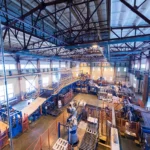While much of the nonresidential construction sector continues to feel the impact of economic headwinds, healthcare construction is charting a different course—maintaining steady growth thanks to resilient planning, evolving design priorities, and long-term investment strategies.
According to Robins & Morton, a leading construction firm headquartered in Birmingham, Alabama, healthcare projects remain robust in the face of market volatility. Insights from their newly released 2025 State of Healthcare Construction report highlight why the healthcare sector is bucking the broader industry trend.
“Healthcare construction is uniquely positioned to weather economic uncertainty,” said Derek Gregg, Vice President of Operations at Robins & Morton. “Demand for medical services remains constant, and the extended timelines associated with healthcare project planning account for market fluctuations.”
In February 2025, healthcare construction spending reached $69.78 billion, reflecting a 2.1% year-over-year increase, according to federal data cited in the report. The continued momentum is credited in part to the need for healthcare systems to modernize their facilities to stay competitive.
Early Contractor Involvement and Flexible Design

Healthcare developers are increasingly involving contractors from the earliest planning stages to manage rising costs, improve risk mitigation, and keep projects on track. This proactive approach is helping healthcare systems navigate inflationary pressures while maintaining focus on core objectives: patient experience, safety, and operational efficiency.
Gregg notes that flexible design and futureproofing are now essential considerations. Projects are being designed with adaptability in mind, allowing facilities to evolve with changing care models, staffing needs, and technology integration.
Sustainability and Resilience Take Center Stage
The report also identifies a growing emphasis on sustainability and climate resilience, particularly in regions prone to natural disasters such as the Southeast and Florida. Clients are investing in energy-efficient systems, hardened infrastructure, and tools like life cycle cost assessments to forecast long-term savings.
“Clients are making data-driven decisions to balance environmental goals with fiscal responsibility,” said Gregg. “Sustainability isn’t just a value—it’s a strategy.”
Certificate of Need Reform and the Competitive Edge
Another trend shaping healthcare construction is Certificate of Need (CON) reform, which is intensifying competition among healthcare providers. In states where CON laws are relaxed or repealed, health systems are building state-of-the-art facilities to attract both patients and top-tier medical talent.
From smart infrastructure to luxury-like amenities, design innovation is becoming a vital differentiator in a crowded healthcare landscape.
Looking Ahead
As healthcare facilities grow in complexity, Gregg emphasized the importance of interdisciplinary collaboration and staying attuned to broader industry and economic signals.
“Healthcare construction requires more than technical expertise—it demands a strategic partnership that aligns facility design with long-term operational goals,” Gregg said.
With flexible, resilient, and forward-thinking strategies in place, the healthcare construction sector is poised to remain a bright spot in an otherwise uncertain construction environment.








